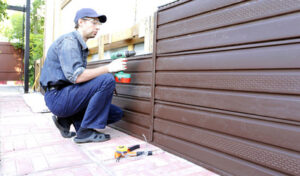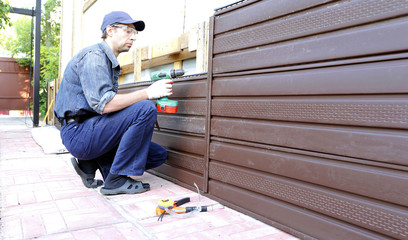Small holes, dents, and cracks in vinyl siding can lead to more extensive damage if not promptly repaired. Inspect your home’s exterior regularly to identify and repair problems as they occur.
To do this, you’ll need a few tools that can be purchased at your local hardware store. You’ll also need a matching paint to ensure the repaired area blends in with the existing vinyl. For professional help, contact Vinyl Siding Repair Charleston SC.
A damaged section of vinyl siding is an eyesore, but it can also allow moisture, wasps and other insects to enter the home through the gap. Replacing these panels is essential to preventing more serious problems and keeping the house looking like new. This project can be easily done as a DIY task, but there are times when calling in a professional is the best option.
The right tools will make the job go much easier. A siding removal tool (also known as a zip tool) is an indispensable part of this task, as it’s designed to unlock the bottom of a panel without damaging it or anything else. A snap lock punch is another must-have for this job, as it can elongate the nail hole slot and make it easy to remove a panel. Other tools that are helpful include a utility knife, a jigsaw and a circular saw with a wood framing blade to speed up cutting, a pair of scissors for trimming the ends of soffit boards, and a set of tin snips or compound aviation-type snips to cut and shape the siding and soffit materials.
To repair a small hole or other damage in vinyl siding, you can use a self-adhesive patch kit that comes with its own directions. Typically, the process involves cleaning and prepping the area around the damage, and then applying the patch, followed by caulking around it. It’s recommended to use a paintable caulk, such as DAP Platinum Patch Advanced Exterior Filler, and then touch-up the spot with some exterior-grade paint to match the surrounding color of your home’s vinyl siding.
For larger holes in vinyl siding, you may be able to find a replacement panel that matches your home’s style and color if you were lucky enough to save one from the last time your house was sided. If not, a fiberglass patch kit is a quick fix that provides a durable and weather-tight solution. Follow the directions in the kit to prepare the area, and then apply the patch and caulk as directed.
Preparation
Vinyl siding is made to be tough and durable, but sometimes it needs repair. If you have chips, cracks, or holes in your vinyl siding, it’s important to fix them quickly before they lead to other problems such as mildew growth, rodents entering the home, and moisture damage. This can be done by patching or replacing the damaged section of vinyl siding. This is a do-it-yourself (DIY) project that can be done by any homeowner with some experience and basic tools.
Before you begin repairing vinyl siding, you need to prepare the area by cleaning it and making sure it is free of dust or dirt. If there is a large amount of dirt or debris in the hole, it may be difficult to properly fix the siding and could lead to more serious problems down the road.
The next step is to check for any nails in the affected vinyl panel and remove them if necessary. Then, cut a spare piece of vinyl siding that is about 2 inches wider on each side than the damaged segment. Make sure the spare piece is a match in color with the surrounding vinyl siding.
You can find matching caulk at any hardware store, and if you’re worried about finding the right shade, many professional contractors will have special paint that is mixed to closely match the existing vinyl siding. Once the caulk is dry, you’re ready to put the new section of vinyl siding in place. Slide the new panel up into place, pushing it up until the bottom lip locks in with the vinyl piece below it. Apply a bead of caulk around the replacement panel to help keep it in place, and let it dry for two hours or more.
Once the caulk has dried, you can trim any excess with scissors, sand the patched area to smooth it, and then primer and paint the vinyl siding. You can use Zinsser Bulls Eye 1-2-3 Primer and an exterior vinyl paint in your chosen color. While repairing and maintaining your vinyl siding will help to prevent future damage, it’s still best to have a professional contractor assist you with larger or more extensive repairs. This will save you time and money in the long run, and ensure your vinyl siding is repaired correctly.
Patching
There are a number of maintenance and repair tasks homeowners can perform to help prolong the life and look of their vinyl siding. One such task is patching up small holes, dents, or lifted panels. While these may seem like minor issues, if left unchecked, they can lead to unwanted moisture entering your home’s structure, which can cause mold, mildew, and further damage. In addition, pests such as wasps, ants, and mice may find their way into your home through holes in or lifting of the vinyl panel.
For smaller holes or dents, using a vinyl siding repair kit is an excellent solution. These kits are designed to make repairs as simple as possible, but still be effective. These types of kits typically use fiberglass, tape, or caulk to create the patch. Regardless of the type of repair kit used, follow the directions to ensure that the repair is made properly.
For larger holes, a backer material should be used to give the patch a stable surface that it can attach to. This material can be a thin strip of wood, or a scrap piece of vinyl siding. Once the backer material is inserted, the hole should be filled with the appropriate caulk and then smoothed to remove any bubbles or uneven surfaces. When the caulk is dry, it should be painted with a matching exterior paint so that it blends in and can’t be seen.
Similarly, for smaller dents or holes, a patch can be created with a kit that uses a fiberglass cloth. This type of patch is often much easier to work with than a caulk or tape patch because it can be molded to the desired shape. Depending on the type of kit used, the cloth may need to be wetted with water prior to applying the caulk.
In some cases, a full panel of vinyl siding may need to be replaced due to damaged or missing sections. This can be a more difficult job than simply patching or replacing a single section, but it is still a doable project for an experienced DIYer. Depending on the size and extent of the damage, it might be better to call in a professional instead of trying to complete the repair yourself.
Painting
The painting that you need to do after your vinyl siding repair is complete is a major task. It’s not as simple as slapping on a coat of paint, and it requires a lot of patience and precision. It can also be time-consuming, so it’s important to plan ahead and make a list of the tools you’ll need before heading to the hardware store.
You should also prepare the surface of the patched area by de-glossing it and sanding it to remove any rough areas. After the sanding, you should apply a primer that is appropriate for vinyl siding. You can purchase vinyl-safe primers at your local hardware store. Once the primer is dry, you can begin to paint. Make sure you use a paint that matches the original color of your vinyl siding. You’ll need to give the paint a day or two to fully dry before it rains.
It’s best to paint on a calm, overcast day, as high humidity and the blazing sun can ruin your finish. You’ll want to avoid the wind, too, as it can cause your paint to sway and wash right off the vinyl.
If you have the foresight to save a few pieces of vinyl from the last time your home was sided, you can use them to replace any damaged areas. This can be easier than trying to match a new piece. It will help if they have the same style and design of the rest of your vinyl, so it won’t stand out as an obvious patch.
When repairing vinyl siding, it’s important to remember that you shouldn’t cover up the damage with other materials, as water and mold can easily get trapped behind it. You’ll also void your warranty, so be careful and do your research before attempting this DIY project.

